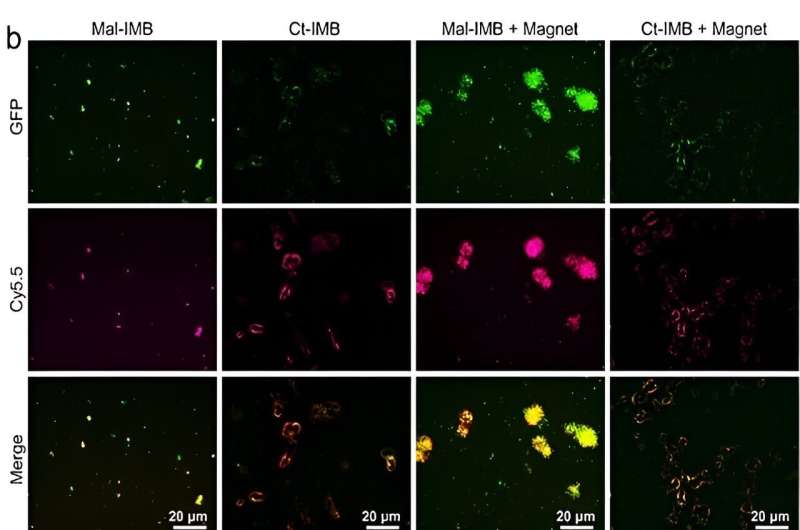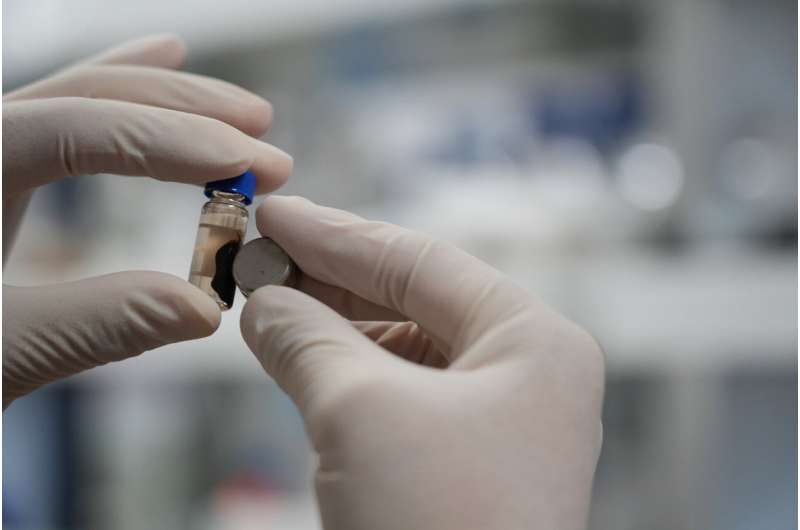This article has been reviewed according to Science X's editorial process and policies. Editors have highlighted the following attributes while ensuring the content's credibility:
fact-checked
peer-reviewed publication
proofread
Novel nano-immune magnetic bead may provide faster way to catch SARS-CoV-2

A more efficient way to test SARS-CoV-2 virus was developed recently by a research team led by Professor Wang Junfeng from Hefei Institutes of Physical Science (HFIPS), Chinese Academy of Science (CAS). The novel nano-immune magnetic bead (Mal-IMB) they developed in this research can efficiently be bound to SARS-CoV-2 pseudovirus in the study of protein biomimetic mineralization and synthesized into magnetic nanoparticles.
The relevant findings were published in Analytical Chemistry.
The novel coronavirus pneumonia caused by the highly contagious SARS-CoV-2 virus has had a significant impact on public health. A convenient and rapid virus separation method is needed. Immune magnetic beads (IMBs),which use magnetic microspheres with specific probes to bind to target substances, have shown significant advantages.
However, applying IMBs in biological separations presents challenges that need to be addressed, such as low target substance concentration and complex biological environments. Small-sized magnetic beads, which can penetrate impurities and reduce nonspecific binding, has been suggested.
In this research, based on previous work on biomimetic mineralization synthesis, the research team modified the surface of ultra-small cluster magnetic nanobeads and combined them with ultra-small single-chain antibody fragments (RBD-scFv) targeting the RBD region of the S protein. In this way, they successfully obtained highly efficient ultra-small immune magnetic beads for identifying RBD antigens and attached them to SARS-CoV-2 pseudovirus.

"This innovative bead is designed to address the challenges of enrichment and detection of the novel coronavirus in complex biological environments," said Ma Kun, member of the team.
Cluster magnetic beads exhibited excellent magnetic properties, high homogeneity, and chemical stability. Furthermore, due to their small size, they demonstrated stable capture capacity and superior binding efficiency, making them a potential solution for the rapid and effective enrichment and separation of COVID-19.
When compared to commercial beads, Mal-IMB exhibited a maximum virus loading capacity of 83 μg/mg in complex biological environments and could effectively enrich pseudoviruses as low as 70 copies/mL.
Additionally, through immunofluorescence and transmission electron microscopy experiments, the mechanism of ultra-small magnetic bead enrichment in complex biological environments was further elucidated, demonstrating not only the effectiveness of the novel immune magnetic beads but also providing valuable insights for their performance improvement in complex biological environments.
More information: Tongxiang Tao et al, Boosting SARS-CoV-2 Enrichment with Ultrasmall Immunomagnetic Beads Featuring Superior Magnetic Moment, Analytical Chemistry (2023). DOI: 10.1021/acs.analchem.3c02257
Journal information: Analytical Chemistry
Provided by Hefei Institutes of Physical Science, Chinese Academy of Sciences





















